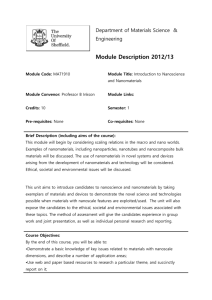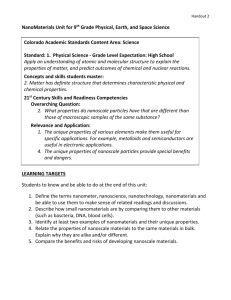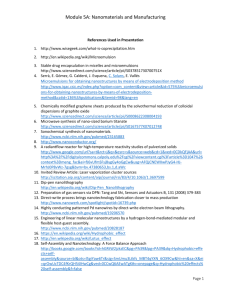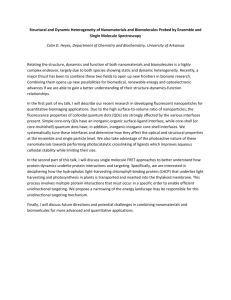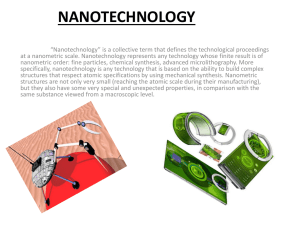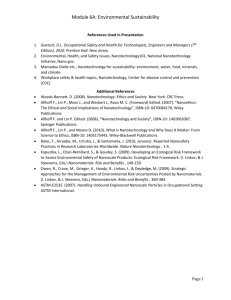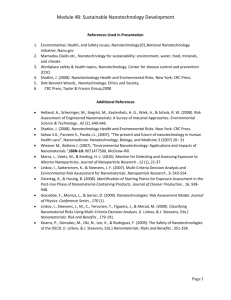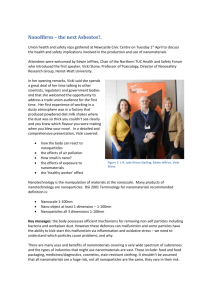AMWU submission `inquiry into nanotechnology in New South
advertisement
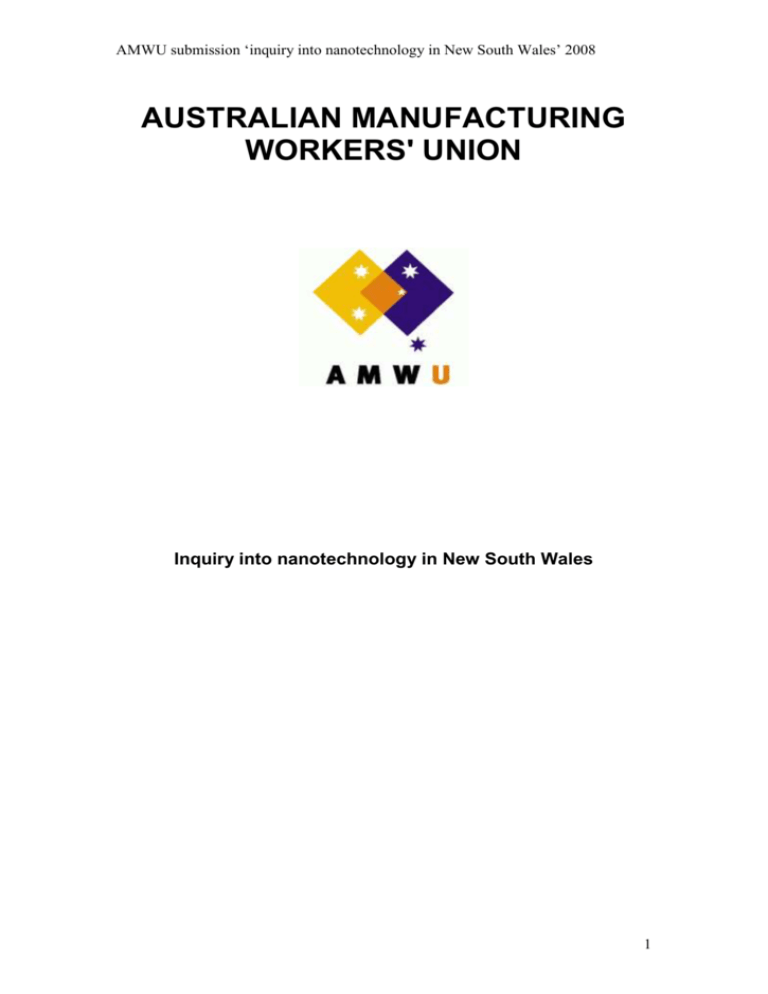
AMWU submission ‘inquiry into nanotechnology in New South Wales’ 2008 AUSTRALIAN MANUFACTURING WORKERS' UNION Inquiry into nanotechnology in New South Wales 1 AMWU submission ‘inquiry into nanotechnology in New South Wales’ 2008 1. The Australian Manufacturing Workers' Union (AMWU) welcomes the opportunity to make a submission to the Inquiry into nanotechnology in New South Wales. 2. The full name of the AMWU is the Automotive, Food, Metals, Engineering, Printing and Kindred Industries Union. The AMWU has a membership of more than 130,000 members who work in every State and Territory of Australia. Our members are employed in the private and the public sectors, in blue collar and white collar positions, and in a diverse range of industries, vocations and locations. 3. The AMWU is the largest manufacturing union in Australia and not only has membership in the manufacturing of nano-products but also in the nanotechnology research arena. 4. Governments and business are falling over themselves to make Australia a commercial hub for a potential 2.5 trillion dollar nanotechnology industry but lip service is being paid to the occupational health and safety risks. 5. The AMWU is concerned about the research showing the potential for serious health impacts on workers exposed particularly during the manufacturing of products using nanotechnology. 6. Studies indicate that ultra fine particles are more toxic than larger particles on a mass for mass basis and current research has identified the potential for a number of disturbing health impacts including lung and cardiovascular disease, brain damage and central nervous system disorders. 7. There is no government regulation in NSW to control the unique risks posed to workers or consumers or to regulate the manufacturers and importers of nano-products.Governments are asleep at the wheel and business sees dollar signs in their eyes. 8. Proponents of a nanotech “revolution” predict that it will cause dramatic and sweeping changes in every aspect of human life.We believe that a precautionary course of action is necessary in order to safeguard the health and safety of the public and workers; conserve our natural environment; ensure public participation and democratically decided social goals; restore public trust in, and support for, government and academic research; and permit long-term commercial viability. 2 AMWU submission ‘inquiry into nanotechnology in New South Wales’ 2008 9. The AMWU as part of this submission seeks the following; The formation of a tripartite oversight body for the purpose of ensuring workers health and safety when working with nanotechnology, Research and development of monitoring systems for nano-particles in workplace environments that can provide accurate information on worker exposure in real time, The development of hazard identification, assessment and control mechanisms, The development of exposure standards that are lower than those currently applied to larger toxic materials, Enact health and safety legislation specifically addressing nanomaterials, Enforce the exposure standards using an active inspectorate, Regulate nano manufactures, labs, suppliers and importers. Such regulation must retroactively cover all nanomaterial products already on the market Register nano manufactures, labs, suppliers and importers, Develop labels for nano materials used in the workplace and as end products, Mandate the monitoring of workers potentially exposed to nanoparticles, Research into the health effects of nanoparticle exposure on humans, Prohibit the marketing of untested or unsafe uses of nanomaterials and requiring product manufactures and distributors to bear the burden of proof. 10. Nanotechnology is the precision engineering of very small particles and materials at the scale of one billionth of a metre (i.e. 1 x 10-9 metres). Nanoparticles are invisible to the human eye and are about one thousandth the width of a human hair. There are many gaps in the knowledge about the potential risks and benefits of nanotechnology. Because of its unique properties, such as its very small size and large surface area to mass ratio, nanotechnology potentially exposes humans to new and increased risks, raising health concerns particularly for workers. The current pace at which nanotechnology is being developed means that occupational health and safety researchers and regulators already lag behind the current industrial environment. 3 AMWU submission ‘inquiry into nanotechnology in New South Wales’ 2008 11. Nanomaterials have a much larger surface to mass ratio compared to larger particles, which may enable them to penetrate cells in the body and take on different structures than they would at their larger scale. Exposure to nanomaterials is most likely to occur through inhalation, but may also occur through the skin or by ingestion. Some studies have indicated that some nanoparticles are able to move from the lungs into the blood stream and be distributed into other organs. Several animal studies suggest that exposure to nanomaterials may cause lung pathologies such as cancers, inflammation, fibrosis and breathing difficulties 12. Governments, universities, and businesses around the world are racing to commercialize nanotechnologies and nanomaterials. Already, hundreds of consumer products either contain nanomaterials (nano-scale chemicals) in the finished product, or are made using nanotechnologies. 13. At the same time, mounting evidence indicates that this new materials revolution poses significant health, safety, and environmental hazards as well as profound social, economic, and ethical challenges. Those speeding the commercialization of nanotechnologies have barely begun the research needed both to clarify and reduce risks and to develop urgently needed ethical, legal and regulatory oversight mechanisms. These mechanisms are required if we are to avoid repeating failures of past “wonder” materials and technologies. 4 AMWU submission ‘inquiry into nanotechnology in New South Wales’ 2008 14. Manufacturing and laboratory settings operate without proper safety guidance or protection measures. Consumers are involuntarily exposed to unlabeled nanomaterial ingredients in products, without being informed of potential risks. 15. Nanomaterials have exploded in the marketplace, billed as miracle substances with remarkable qualities that make them desirable in almost every sector of the economy. Like asbestos when it was first introduced to the market, the public health and environmental impacts of nanomaterials have been poorly studied. 16. Even more so than asbestos, nanomaterials possess qualities (shape, size, chemical reactivity) that have the potential to make them especially risky. Nanomaterials are being sold to the public at large in consumer products, without any notice or warning of their potential hazard. In addition, like the tobacco industry, nano-industries seem content to market their products without fully understanding the potential risks or informing the public of those risks. 17. It is well established that particular forms of asbestos are causative factors in otherwise rare, occupationally derived, malignant mesotheliomas (Robinson & Lake 2005) and other lung disorders (inc. pulmonary interstitial fibrosis, pleural plaques, calcification and thickening) (US CDC 2001). Numerous toxicological studies have established that the absolute physical size of an asbestos fibre is secondary to an aspect (i.e. length to width) ratio of ≥3:1 in mesothelioma formation. Current manufacturing techniques can achieve similar aspect ratios of 3:1 or greater, the biopersistence properties and physical similarities to asbestos are noteworthy. 18. Inadequate funding and the lack of a governmental emphasis on human health risk research enabled the current situation in which some people are exposed to manufactured nanomaterials daily despite a plethora of data on potential long-term or chronic effects of those materials. 19. Initial research into the health effects of nanotechnology indicates that it has the potential to cause inflammation, cancers and serious lung diseases. Comparisons have been drawn between nanotechnology and asbestos particularly in regards to the potential for long latency periods. 20. Free nanoparticles (nanomaterials that are not bound up in other materials) are of particular concern because they appear most likely to enter the body, react with cells, and cause tissue damage. Embedded nanoparticles also pose exposure concerns. Workers may be exposed to such materials throughout the manufacturing process, while disposal and recycling activities may expose the public and the environment. 21. Due to their size, nanoparticles can cross biological membranes, cells, tissues, and organs more readily than larger particles. When inhaled, they 5 AMWU submission ‘inquiry into nanotechnology in New South Wales’ 2008 can go from the lungs into the blood system. There is growing evidence that some nanomaterials may penetrate intact skin, especially in the presence of surfactants or massaging or flexing of the skin, and gain access to systemic circulation. When ingested, nanomaterials may pass through the gut wall and into the blood circulation. Once in the blood stream, nanomaterials can circulate throughout the body and can lodge in organs and tissues including the brain, liver, heart, kidneys, spleen, bone marrow, and nervous system. Once inside cells, they may interfere with normal cellular function, cause oxidative damage and even cell death. 22. Existing research on the impacts of nanomaterials on human health and the environment have raised red flags that warrant precautionary action and further study. Because the potential toxicity of nanoscale materials cannot be reliably predicted from their toxicity profile in bulk (non-nano) form, regulations must require rigorous, accurate and comprehensive premarket safety assessments that take into consideration the unique properties of nanomaterials. 23. OHS practitioners recognise that there is a lack of reliable and consistent guidance for the safe handling of nanomaterials. The main reason for this is the unknown risks that nanomaterials pose to workers. It has been suggested that until preliminary findings and hypotheses regarding these concerns are confirmed a precautionary approach to the use of nanoproducts should be adopted (US NIOSH 2005b). 24. A precautionary approach in the unions view is fundamental. A precautionary approach requires mandatory, nano-specific oversight mechanisms to account for the unique characteristics of the materials. Within those mechanisms, the protection of public health and worker safety requires a committed focus on critical risk research and immediate action to mitigate potential exposures until safety is demonstrated. 25. Oversight must be transparent and provide public access to information regarding decision-making processes, safety testing and products. 26. Adequate and effective nanomaterial oversight requires an immediate emphasis on preventing known and potential exposures to nanomaterials that have not been proven safe. This is essential for nano-industry workers because some materials present potential hazards and others are largely untested. 27. Assessment and oversight of nanomaterials requires mechanisms ensuring transparency, including labelling of consumer products that contain nanomaterials, installing workplace right to know laws and protective measures, and developing a publicly accessible inventory of health and safety information. 28. The Precautionary Principle must be applied to nanotechnologies because scientific research to-date suggests that exposure to at least some 6 AMWU submission ‘inquiry into nanotechnology in New South Wales’ 2008 nanomaterials, nanodevices, or the products of nanobiotechnology is likely to result in serious harm to human health and the environment. 29. Worldwide investment in nanotechnology research and development has increased dramatically over recent years. Current investment in the promotion of the industry by far outweighs the spending on research into the potential risks to humans. The AMWU call for a moratorium on the research, development and production of nanotechnology while regulations are developed to protect workers and the public from potential harm. Health and safety effects must be assessed prior to commercialization. 30. The position put forward by the paper ‘A Review of the Potential Occupational Health & Safety Implications of Nanotechnology’ commissioned by the ASCC proposes that: “Until appropriate workplace exposure standards can be established, the nanotechnology industry should control exposures through the applications of risk management programs using the ‘As Low As Reasonably Achievable’ (ALARA) approach to ensure that worker exposure is kept to an absolute minimum”. 31. The problem with this proposal is there is no way to monitor the exposure of workers to nanoparticles or for that the exposure in the working environments. There is also no known safe level of exposure. 32. Due to the limited knowledge of the health and safety impacts of occupational exposure to nanotechnology, it is currently impossible to carry out a precise, quantitative risk assessment. 33. It is difficult to currently apply OHS legislation to nanotechnology due to the identified difficulties in undertaking a risk assessment and developing a risk management plan. An effective gap analysis of how existing legislation applies to nanotechnology will not be possible until further knowledge of measurement procedures and exposure levels is gained. 34. Current legislation provides inadequate oversight of nanomaterials. A modified nano-specific regulatory regime must be an integral aspect of the development of nanotechnologies. 35. Even where legal authority exists, substantial regulatory changes in existing laws are likely to be necessary in order to adequately and effectively address the fundamentally different properties of nanomaterials and new challenges that nanomaterials present. Regulatory actions must retroactively cover all nanomaterial products already on the market. 36. Voluntary initiatives are wholly inadequate to oversee nanotechnology. Voluntary programs lack incentives for those with risky products to participate, thus leaving out the entities most in need of regulation. Voluntary initiatives often delay or weaken essential regulation, forestall 7 AMWU submission ‘inquiry into nanotechnology in New South Wales’ 2008 public involvement, and limit public access to vital environmental safety and health data. For these reasons, the public overwhelmingly prefers mandatory governmental oversight to voluntary initiatives. 37. Despite the burgeoning nano-workforce, no existing occupational safety and health standard specifically addresses nanotechnologies and nanomaterials, and there are no accepted standard methods for measuring human exposure to nanomaterials in the workplace. 38. Any regulatory regime designed to protect workers from the health effects of nanomaterials requires written comprehensive health and safety programs addressing workplace nanotechnology issues. Employers should use the precautionary principle as the basis for implementing protective measures for assuring the health and safety of workers. 39. The hierarchy of exposure controls—elimination, substitution, isolation engineering controls, work practice/administrative approaches, and personal protective equipment— should be employed. Exposure monitoring, medical surveillance and worker training are necessary to ensure that workers receive the most up-to-date information on nanomaterials. Workers and their representatives should be involved in all aspects of workplace nanotechnology health and safety issues without fear of retaliation or discrimination. Finally, existing occupational, safety and health standards must be scrutinized for their applicability to nanomaterials. 40. Developers and manufacturers must be stewards responsible for the safety and effectiveness of their processes and products, and retain liability for any adverse impacts stemming from them. This includes prohibiting the marketing of untested or unsafe uses of nanomaterials and requiring product manufacturers and distributors to bear the burden of proof. 41. Safety testing data must be available for public scrutiny. In light of the poor record of industry in preventing workplace exposures and environmental releases of hazardous chemicals, effective oversight should include strictures on the use of confidentiality shields for nanomaterials. The provisions of international conventions on public access to information should be respected. 42. All who market nano-products, including nanomaterial developers, handlers and commercial users, the makers of products containing nanomaterials and retailers who sell nano-containing products to the public must be held accountable for liabilities incurred from their products. While product liability claims are the most likely liability for the nanomaterials industry, other forms of liability, including workers compensation, negligence, derivative liability, nuisance, fraud and misrepresentation are relevant. 8 AMWU submission ‘inquiry into nanotechnology in New South Wales’ 2008 43. Nanomaterial oversight regimes must include financial mechanisms, funded by manufacturers and distributors, ensuring that funds are available to compensate and/or remediate any potential health, worker, or environmental damages. Potential injured parties include individual members of the general public, classes of individuals who have experienced similar harm (such as workers or users of consumer products), federal, state and local governments (or units thereof), foreign nations, investors, insurance companies, and unions. Both those funding commercialisation and those actively engaged in nanotechnology sectors are responsible for the adequacy of the product stewardship and any damage incurred because of failure to take precautionary protective actions to protect people or the environment. Thankyou 9
